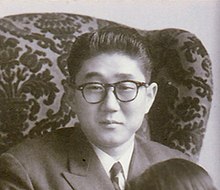Shintaro Abe
Shintaro Abe | |
|---|---|
安倍 晋太郎 | |
 | |
| Minister of Foreign Affairs | |
| In office 27 November 1982 – 22 July 1986 | |
| Prime Minister | Yasuhiro Nakasone |
| Preceded by | Yoshio Sakurauchi |
| Succeeded by | Tadashi Kuranari |
| Minister of International Trade and Industry | |
| In office 30 November 1981 – 27 November 1982 | |
| Prime Minister | Zenkō Suzuki |
| Preceded by | Rokusuke Tanaka |
| Succeeded by | Sadanori Yamanaka |
| Chief Cabinet Secretary | |
| In office 28 November 1977 – 7 December 1978 | |
| Prime Minister | Takeo Fukuda |
| Preceded by | Sunao Sonoda |
| Succeeded by | Rokusuke Tanaka |
| Minister of Agriculture and Forestry | |
| In office 9 December 1974 – 15 September 1976 | |
| Prime Minister | Takeo Miki |
| Preceded by | Tadao Kuraishi |
| Succeeded by | Buichi Ōishi |
| Personal details | |
| Born | 29 April 1924 Tokyo City, Tokyo Prefecture Empire of Japan |
| Died | 15 May 1991 (aged 67) Tokyo, Japan |
| Political party | Liberal Democratic Party |
| Spouse | Yoko |
| Children | Hironobu Abe Shinzō Abe Nobuo Kishi (adopted) |
| Parent(s) | Kan Abe Shizuko Abe |
| Alma mater | University of Tokyo |
Shintaro Abe (安倍 晋太郎, Abe Shintarō, 29 April 1924 – 15 May 1991)[1] was a Japanese politician from Yamaguchi Prefecture. He was a leading member of the ruling Liberal Democratic Party (LDP). He served as foreign minister from 1982 to 1986.[2]
Early life and education
Abe was born in Tokyo on April 29, 1924. He was raised in his father's home prefecture of Yamaguchi from soon after his birth. He was the eldest son of politician and member of Parliament Kan Abe. His mother was an army general's daughter.[3]
Career
After graduating from high school in 1944 during World War II, Abe entered a naval aviation school and volunteered to become a kamikaze pilot. The war ended before he could undergo the required training.[4] In 1949 he graduated from the Faculty of Law at the University of Tokyo, Shintaro Abe began his career as a political reporter for Mainichi Shimbun.[5] He became a politician in 1957, when he started working as a legislative aide of the then-prime minister Nobusuke Kishi.[5] He won his father's seat in the House of Representatives in 1958.[3]
He led a major LDP faction, the conservative Seiwa Seisaku Kenkyūkai, whose reins he took from former Prime Minister Takeo Fukuda in July 1986, and held a variety of ministerial and party posts, the former of which included Minister of Agriculture and Forestry and Minister of International Trade and Industry.[3] Abe was named as Minister of International Trade and Industry in the cabinet of the then prime minister Zenkō Suzuki on November 30, 1981.[6] During this period, he was seen as a young leader groomed for the future prime ministry.[6] In November 1982, he was appointed Minister for Foreign Affairs in the cabinet of the then-prime minister Yasuhiro Nakasone, replacing Yoshio Sakurauchi. His term lasted until 1986.[2]

Abe was a top contender to succeed Nakasone as prime minister in 1987, until he stepped aside for Noboru Takeshita, head of a powerful rival faction. Then, he was given the post of secretary general of the party in 1987.[2] In 1988, his chances of becoming prime minister some time in the near future were again thwarted when his name became associated with the Recruit-Cosmos insider-trading stock scandal, which brought down Takeshita and forced Abe to resign as the party's secretary general in December 1988.[2]
Personal life
Abe married Yoko Kishi, daughter of Prime Minister Nobusuke Kishi, in 1951.[2] His second son, Shinzō Abe, became prime minister on September 26, 2006 and December 26, 2012.[7]
Death
Abe was hospitalized in January 1991.[3] He died of heart failure at Tokyo's Juntendo University Hospital on May 15, 1991.[5]
Honours
From the corresponding article in the Japanese Wikipedia
- Grand Cordon of the Order of the Rising Sun with Order of the Paulownia Flowers
References
- ^ "Abe, Shintaro". Who Was Who in America, with World Notables, v. 10: 1989-1993. New Providence, NJ: Marquis Who's Who. 1993. p. 1. ISBN 0837902207.
- ^ a b c d e Yates, Ronald E. (May 16, 1991). "Shintaro Abe, 67". Chicago Tribune. Retrieved January 1, 2013.
- ^ a b c d "Shintaro Abe; Ex-Japanese Foreign Minister". Los Angeles Times. Tokyo. May 16, 1991. Retrieved January 1, 2013.
- ^ Shintaro Abe, Japanese Politician And Ex-Cabinet Aide, Dies at 67, by James Sterngold, The New York Times, May 16, 1991
- ^ a b c "Shintaro Abe, Japanese Political Leader". The Seattle Times. May 15, 1991. Retrieved January 1, 2013.
- ^ a b "Japan's cabinet shuffled". Spokane Daily Chronicle. Tokyo. UPI. November 30, 1981. Retrieved January 1, 2013.
- ^ "Profile: Shinzo Abe". BBC. December 17, 2012. Retrieved January 1, 2013.
- 1924 births
- 1991 deaths
- Foreign ministers of Japan
- Government ministers of Japan
- Members of the House of Representatives (Japan)
- Politicians from Yamaguchi Prefecture
- University of Tokyo alumni
- Liberal Democratic Party (Japan) politicians
- Recipients of the Order of the Rising Sun with Paulownia Flowers
- Shinzo Abe
